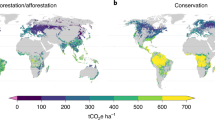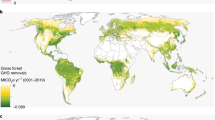Abstract
replying to C. D. Holmes Nature507,http://dx.doi.org/10.1038/nature13113(2014)
Forests have become more efficient at using water over the past two decades1. A series of hypotheses exist to explain this trend, but the only credible explanation to date is a response to rising atmospheric CO2. Keenan et al.1 show that the observed trend is physiologically plausible, but is much larger than expected from conventional theory and experimental evidence. This has led to suggestions that processes other than increased atmospheric CO2 may have contributed to the observed trend2. One such process that has yet to be examined is the effect of tropospheric ozone on forest water-use efficiency (WUE). In the accompanying Comment3, Holmes reports that ozone concentrations have declined in the northeastern and midwestern USA by about 50% from 1995 to 2010. Using empirical relationships, he estimates that this decline could explain roughly 15% of the reported increase in WUE over North America, and a significantly lower proportion of the trend in Europe.
This is a preview of subscription content, access via your institution
Access options
Subscribe to this journal
Receive 51 print issues and online access
$199.00 per year
only $3.90 per issue
Buy this article
- Purchase on Springer Link
- Instant access to full article PDF
Prices may be subject to local taxes which are calculated during checkout

Similar content being viewed by others
References
Keenan, T. F. et al. Increase in forest water-use efficiency as atmospheric carbon dioxide concentrations rise. Nature 499, 324–327 (2013)
Medlyn, B. E. & De Kauwe, M. Carbon dioxide and water use in forest plants. Nature 499, 287–289 (2013)
Holmes, C. D. Air pollution and forest water use. Nature 507, http://dx.doi.org/10.1038/nature13113 (2014)
Lombardozzi, D., Sparks, J. P. & Bonan, G. Integrating O3 influences on terrestrial processes: photosynthetic and stomatal response data available for regional and global modeling. Biogeosciences 10, 6815–6831 (2013)
Parrish, D. D. et al. Long-term changes in lower tropospheric baseline ozone concentrations at northern mid-latitudes. Atmos. Chem. Phys. 12, 11485–11504 (2012)
Cooper, O. R. et al. Increasing springtime ozone mixing ratios in the free troposphere over western North America. Nature 463, 344–348 (2010)
Cooper, O. R., Gao, R.-S., Tarasick, D., Leblanc, T. & Sweeney, C. Long-term ozone trends at rural ozone monitoring sites across the United States, 1990–2010. J. Geophys. Res. 117, D22307 (2012)
Author information
Authors and Affiliations
Corresponding author
PowerPoint slides
Rights and permissions
About this article
Cite this article
Keenan, T., Hollinger, D., Bohrer, G. et al. Keenan et al. reply. Nature 507, E2–E3 (2014). https://doi.org/10.1038/nature13114
Published:
Issue Date:
DOI: https://doi.org/10.1038/nature13114
Comments
By submitting a comment you agree to abide by our Terms and Community Guidelines. If you find something abusive or that does not comply with our terms or guidelines please flag it as inappropriate.



